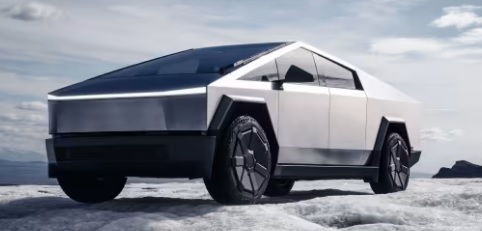Key specs
Tesla Cybertruck (Pick-up) Cybertruck 2023,2024,2025,2026
What is the body type, Tesla Cybertruck 123 kWh (600 Hp) Dual Motor AWD 2023?
Pick-up, 4 Doors, 5 Seats
How fast is the car, Tesla Cybertruck 123 kWh (600 Hp) Dual Motor AWD 2023?
180 km/h, Electronically limited 111.85 mph
How many cylinders, Tesla Cybertruck 123 kWh (600 Hp) Dual Motor AWD 2023?
Electric,
What is the drivetrain, Tesla Cybertruck 123 kWh (600 Hp) Dual Motor AWD 2023?
All wheel drive (4x4),
How long is this vehicle, Tesla Cybertruck 123 kWh (600 Hp) Dual Motor AWD 2023?
5683 mm
223.74 in.
How wide is the vehicle, Tesla Cybertruck 123 kWh (600 Hp) Dual Motor AWD 2023?
2413 mm
95.01 in.
What is the curb weight, Tesla Cybertruck 123 kWh (600 Hp) Dual Motor AWD 2023?
2995 kg
6602.84 lbs.
Tesla Cybertruck (Pick-up) Cybertruck 2023,2024,2025,2026 Specs
General information
| Brand |
Tesla |
| Model |
Cybertruck (Pick-up) |
| Version |
Cybertruck |
| Engine version |
123 kWh (600 Hp) Dual Motor AWD |
| Year production start |
2023 |
| Vehicle type |
Pick-up |
| Acceleration 0 - 100 kmh sec |
4.3 sec |
| Curb weight kg -lbs total |
2995 kg
6602.84 lbs.
|
| Overall length mm - inch |
5683 mm
223.74 in.
|
| Doors |
4 |
| Top Speed |
180 km/h, Electronically limited 111.85 mph |
Engine specs
| Cylinders |
Electric |
| Weight / horsepower kg/hp - hp/tons |
5 kg/Hp
200.3 Hp/tonne
|
| Fuel type |
Electricity |
| Battery |
Liquid-cooled lithium ion (Li-ion) 700 V
|
| Powertrain architecture |
BEV (Electric Vehicle) |
| Electric motor power |
297 Hp
|
| Total available power |
600 Hp
|
| Eng 56 |
Battery -123 kWh
|
| Eng 57 |
Electric unit layout - Front axle, Transverse
|
| Eng 59 |
rear engine 1 AC permanent magnet synchronous motor, liquid-cooled, with variable frequency drive.
|
Transmission and Drive system
| Drive configuration |
All wheel drive (4x4)
|
| Transmission |
Single speed fixed gear |
| Gear ratio 1st 2nd 3rd 4th 5th 6th reverse |
Reverse direction of motor, limited to 15 mph (24 km/h). |
| Final drive ratio |
Front and Rear unit motors: 15.02:1 |
Brakes
| Front brakes |
four pistons fixed caliper, 351mm -13.8 in ventilated rotors |
| Rear brakes |
Single piston, floating caliper, 356 mm 14 in. ventilated rotors |
| Anti-lock brake system |
ABS (Anti-lock braking system) |
| Parking brake |
Electrically actuated parking brake calipers |
Steering
| Steering type |
4-wheel directional steer-by-wire |
| Turns (lock-to-lock) |
0.94 (340 degrees) |
| Turning diameter m - ft |
Approximately 13.25 m
- 43.5 ft
|
Suspension
| Front suspension |
Independent, double wishbone, air spring with adaptive damper, stabilizer bar. |
| Rear suspension |
Independent, double wishbone, air spring with adaptive damper, stabilizer bar. |
Passenger
| Passengers seats |
5 |
| Trunk space min liter | cu. Ft. |
1897 l
66.99 cu. ft.
|
| Trunk space max liter | cu. Ft. |
3423 l
120.88 cu. ft.
|
Dimensions
| Overall length mm - inch |
5683 mm
223.74 in.
|
| Overall width mm -inch |
2413 mm
95.01 in.
|
| Overall height mm -inch |
medium air setting 1796 mm
70.7 in.
|
| Wheelbase mm - inch |
3635 mm
143.11 in.
|
| Track width front mm - inch |
1772 mm
69.8 in.
|
| Track width rear mm - inch |
1772 mm
69.8 in.
|
| Dimensions-168 |
ground clearance very high air setting 356 mm 14.0 in. |
| Dimensions-169 |
cargo bed length 1852 mm 72.9 in. |
| Dimensions-170 |
cargo bet width 1295 mm 51 in. |
Weights
| Curb weight kg -lbs total |
2995 kg
6602.84 lbs.
|
| Gross weight kg -lbs total |
4129 kg
9102.89 lbs.
|
| Capacities kg - lbs |
1134 kg
2500.04 lbs.
|
| Weights-178 |
max towing capacity 4990 kg 11,000 lbs |
Engine type
Electric
https://www.thecarspec.com/components/engine/electric

